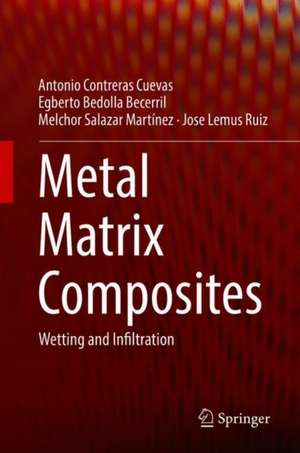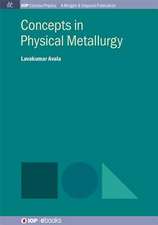Metal Matrix Composites: Wetting and Infiltration
Autor Antonio Contreras Cuevas, Egberto Bedolla Becerril, Melchor Salazar Martínez, José Lemus Ruizen Limba Engleză Hardback – 7 noi 2018
| Toate formatele și edițiile | Preț | Express |
|---|---|---|
| Paperback (1) | 562.10 lei 38-44 zile | |
| Springer International Publishing – 6 dec 2018 | 562.10 lei 38-44 zile | |
| Hardback (1) | 648.56 lei 43-57 zile | |
| Springer International Publishing – 7 noi 2018 | 648.56 lei 43-57 zile |
Preț: 648.56 lei
Preț vechi: 763.01 lei
-15% Nou
Puncte Express: 973
Preț estimativ în valută:
124.10€ • 129.90$ • 103.29£
124.10€ • 129.90$ • 103.29£
Carte tipărită la comandă
Livrare economică 31 martie-14 aprilie
Preluare comenzi: 021 569.72.76
Specificații
ISBN-13: 9783319918532
ISBN-10: 3319918532
Pagini: 331
Ilustrații: XXII, 310 p. 208 illus., 84 illus. in color.
Dimensiuni: 155 x 235 x 25 mm
Greutate: 0.64 kg
Ediția:1st ed. 2018
Editura: Springer International Publishing
Colecția Springer
Locul publicării:Cham, Switzerland
ISBN-10: 3319918532
Pagini: 331
Ilustrații: XXII, 310 p. 208 illus., 84 illus. in color.
Dimensiuni: 155 x 235 x 25 mm
Greutate: 0.64 kg
Ediția:1st ed. 2018
Editura: Springer International Publishing
Colecția Springer
Locul publicării:Cham, Switzerland
Cuprins
Introduction.- Wettability.- Composites fabrication techniques.- Fabrication and characterization of composites.- Joining of composites.- Corrosion of composites.- Wear of composites.- Author index.- Subject index.
Notă biografică
.Dr. Antonio Contreras Cuevas received his bachelor’s degree in mechanical engineering in 1994, and the master’s degree in Metallurgy and Materials Science at Universidad Michoacana, México in 1997. In 2002, he obtained his Ph.D. in Metallurgy and Materials Science from Universidad Nacional Autónoma de México (UNAM), researching metal matrix composites. Since 2003, he has been a pipeline materials researcher for the Mexican Petroleum Institute. He is a member of NACE and the Mexican Materials Society, and he belongs to the National Research System Level 2. His main research areas include stress corrosion cracking (SCC), pipeline integrity, root cause analysis (RCA), materials characterization and synthesis and characterization of composite materials. He is the author of more than 60 scientific papers related to materials characterization by different techniques.
Dr. José Lemus-Ruiz obtained his Bachelor´s degree in Physics and Mathematics (1991) and Master degree in Metallurgy and Materials Science (1994), both at Universidad Michoacana in Mexico. He received his Ph.D. in Materials Science at McGill University, Canada in 2000. Topics of expertise include: similar and dissimilar joining by liquid and solid diffusion bonding, metal/ceramic interactions, synthesis and characterization of ceramics, and metal matrix composites. He is a Lecturer and Researcher at the Institute of Metallurgical and Materials Research at Universidad Michoacana, and currently he is making a visting researcher at Concordia University in Montreal, Canada. He has published more than 70 scientific papers in international journals and symposia proceedings.
Dr. José Egberto Bedolla Becerril obtained his Bachelor´s degree in Electrical Engineering (1974)at Universidad Michoacana in Mexico. He obtained his Ph.D. in Materials Science from Newcastle University, U.K. in 1980. He has published more than 120 scientific papers in international journals and symposia proceedings. His areas of expertise include pyrometallurgical processing and the synthesis and characterization of composites materials. He is a member of the Mexican Materials Society, and he belongs to the National Research System Level 2. He is a Lecturer and Researcher at the Institute of Metallurgical and Materials Research at Universidad Michoacana, México.
Dr. Melchor Salazar Martínez obtained his Master’s degree and Ph.D. in metallurgy and materials science at the Metallurgy and Materials Research Institute of Universidad Michoacana, México, in 1997 and 2002 respectively. He carried out postdoctoral work in at the Mexican Petroleum Institute. Since 2003, he has been a researcher at Mexican Petroleum Institute in a number of programs including Pipeline Integrity and the Exploitation of Fields in Deep Waters. His research areas are materials for offshore and deep-water applications, sulphide stress corrosion cracking (SSCC), hydrogen induced cracking (HIC), and prevention and analysis of failure. He is the author of more than 25 scientific papers.Dr. José Lemus-Ruiz obtained his Bachelor´s degree in Physics and Mathematics (1991) and Master degree in Metallurgy and Materials Science (1994), both at Universidad Michoacana in Mexico. He received his Ph.D. in Materials Science at McGill University, Canada in 2000. Topics of expertise include: similar and dissimilar joining by liquid and solid diffusion bonding, metal/ceramic interactions, synthesis and characterization of ceramics, and metal matrix composites. He is a Lecturer and Researcher at the Institute of Metallurgical and Materials Research at Universidad Michoacana, and currently he is making a visting researcher at Concordia University in Montreal, Canada. He has published more than 70 scientific papers in international journals and symposia proceedings.
Textul de pe ultima copertă
This book covers several aspects of the synthesis of composites by the pressureless infiltration technique. It describes the methods used to obtain green preforms, such as cold pressed and hot sintering, describing the heating time, load, and time required for pressing the preforms. Additionally, wettability phenomena, which is directly related on infiltration, is extensively described. Wettability process and interfacial reactions are analyzed in many ceramic-metal systems prior to fabricate the composites. A complete description of fabrication processes for Metal Matrix Composites is included. An extensive section on structural, chemical, and mechanical characterization of composites fabricated with aluminum and magnesium alloys as matrices reinforced with titanium carbide (TiC), aluminum nitride (AlN), silicon carbide (SiC) and alumina (Al2O3) is included. Relevant techniques for joining composites, such as welding and brazing are addressed. As well as issues pertaining to the corrosion and wear of composites are discussed as well. Corrosion behavior of some composites exposed to aqueous media was analyzed. Corrosion of composites using TiC and SiC like reinforcement and Al, Ni, and some Al-Cux, Al-Mgx and Al-Cu-Li alloys like matrix is discussed extensively. The structural characterization techniques addressed include: scanning electron microscopy (SEM), X-ray diffraction (XRD), transmission electron microscopy (TEM), optical microscopy (OM), differential thermal analysis (DTA), high resolution transmission electron microscopy (HRTEM), and thermogravimetry analysis (TGA). Mechanical testing including hardness, elastic modulus, tension tests, and impact tests were used in the characterization of composites. Theoretical models for prediction of some mechanical properties are included too.
Caracteristici
Addresses the fabrication process and characterization of composites with several matrix and reinforcement materials. Discusses structural, chemical, and mechanical characterization of composites fabricated with aluminum and magnesium alloys as matrices reinforced with titanium carbide (TiC), aluminum nitride (AlN), silicon carbide (SiC) and alumina (Al2O3). Focuses on the pressureless infiltration technique while considering wetting, joining, wear and corrosion issues.


















